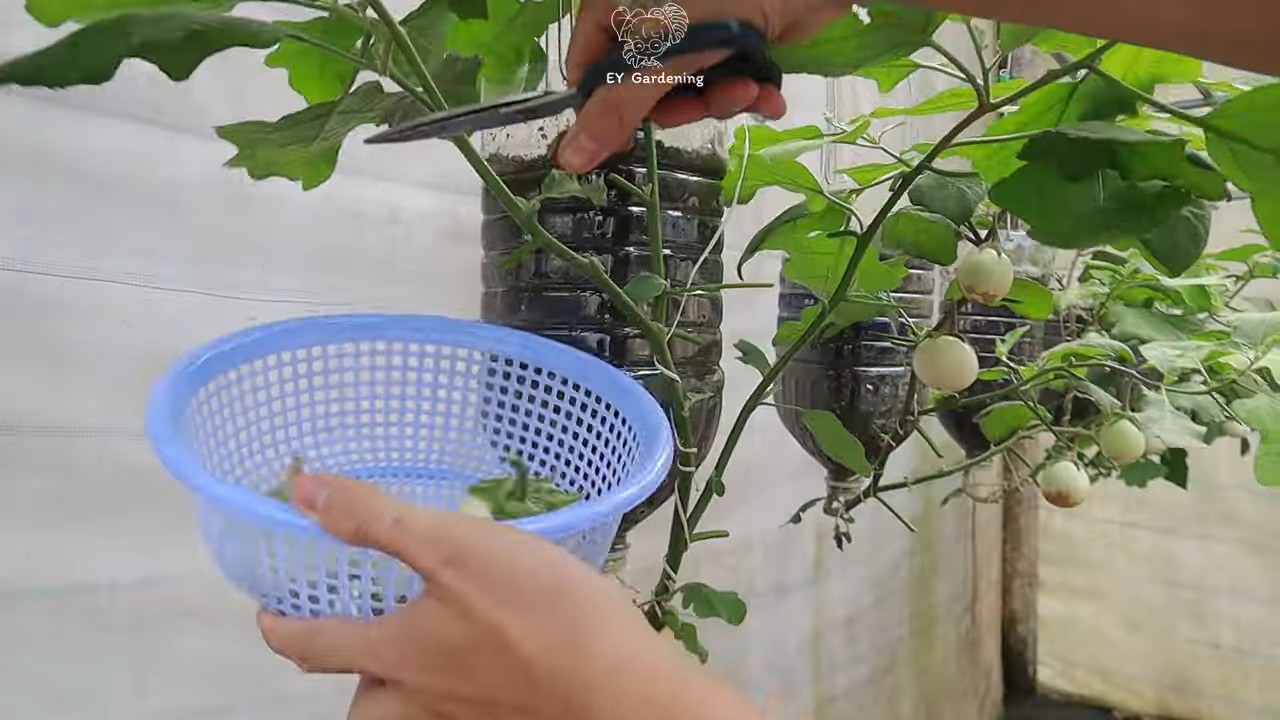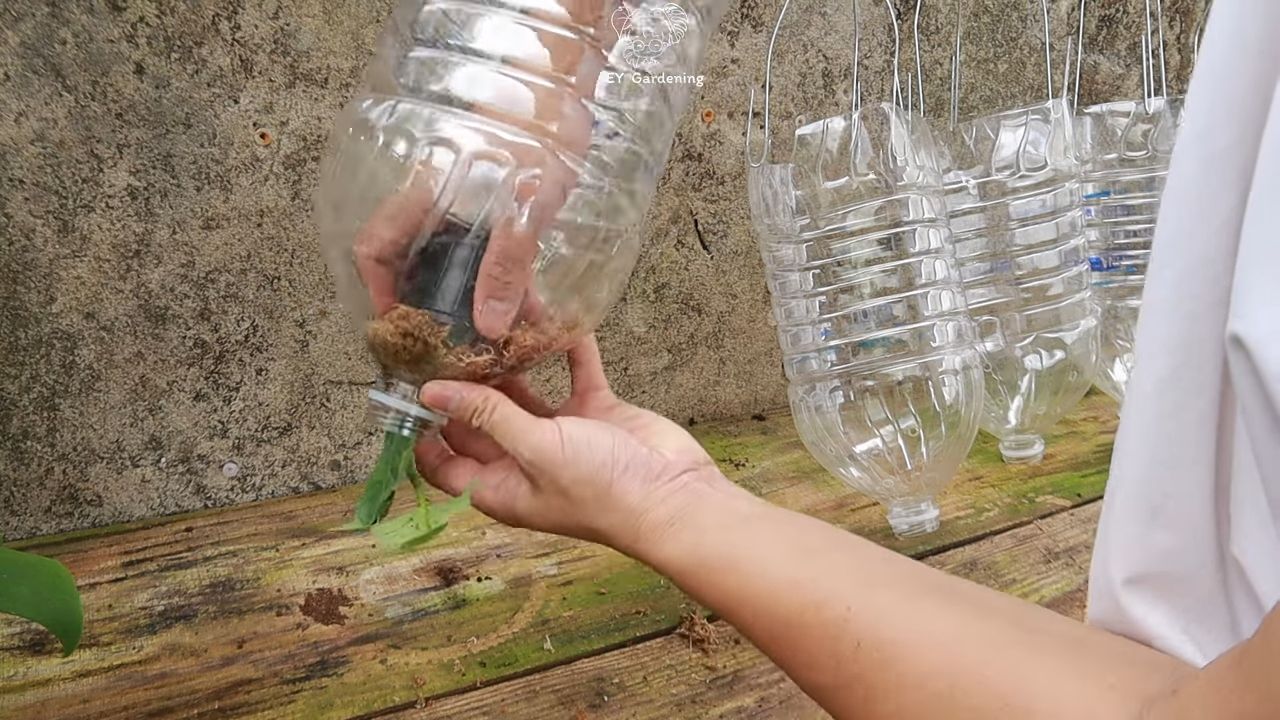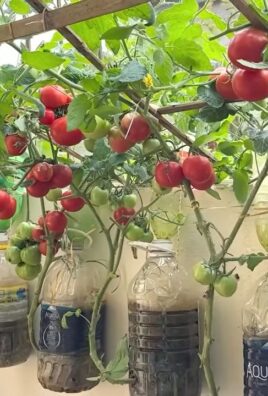Hanging eggplant gardening might sound like something out of a whimsical fairytale, but I’m here to tell you it’s a surprisingly practical and rewarding way to grow these delicious vegetables! Forget sprawling gardens and battling ground-dwelling pests; we’re taking our eggplant game vertical!
For centuries, humans have cultivated eggplants, tracing their origins back to ancient India. While traditionally grown in the earth, innovative gardeners have always sought new methods to maximize space and yield. This brings us to the beauty of hanging baskets. Imagine vibrant purple eggplants dangling like ornaments, adding a touch of rustic charm to your patio or balcony. It’s not just about aesthetics, though.
Why should you consider this DIY trick? Well, for starters, it’s perfect for those with limited space. Apartment dwellers, balcony gardeners, and anyone looking to maximize their harvest will find hanging eggplant gardening a game-changer. Plus, hanging your eggplants keeps them away from soil-borne diseases and pesky critters like snails and slugs. I’m excited to share some simple, effective DIY tricks that will have you harvesting your own homegrown eggplants in no time. Let’s get started!

DIY Hanging Eggplant Garden: From Seed to Stunning Display
Hey there, fellow gardening enthusiasts! Ever thought about growing eggplants, but you’re short on space or just want to try something a little different? Well, get ready to be amazed because today, I’m going to walk you through creating your very own hanging eggplant garden! It’s a fantastic way to add a touch of whimsy and fresh produce to your balcony, patio, or even indoors. Plus, it’s surprisingly easy!
Why Hanging Eggplants?
Before we dive in, let’s talk about why hanging eggplants are a great idea:
* Space Saver: Perfect for small spaces like balconies, patios, or apartments.
* Pest Control: Hanging plants are less susceptible to ground-dwelling pests.
* Improved Air Circulation: Better airflow reduces the risk of fungal diseases.
* Unique Aesthetic: Adds a beautiful and unusual element to your garden.
* Easier Harvesting: No more bending over to pick your eggplants!
What You’ll Need
Okay, let’s gather our supplies. Here’s what you’ll need to create your hanging eggplant masterpiece:
* Eggplant Seedlings: Choose compact or dwarf varieties like ‘Patio Baby,’ ‘Hansel,’ or ‘Fairy Tale.’ These are bred to thrive in containers.
* Hanging Baskets or Pots: Opt for baskets or pots that are at least 12 inches in diameter. Fabric grow bags also work well and are lightweight.
* Potting Mix: Use a high-quality, well-draining potting mix. Avoid garden soil, as it can compact and hinder drainage.
* Slow-Release Fertilizer: Eggplants are heavy feeders, so a slow-release fertilizer will provide them with the nutrients they need throughout the growing season.
* Watering Can or Hose: For regular watering.
* Scissors or Pruning Shears: For trimming and pruning.
* Hanging Hardware: Sturdy hooks, chains, or rope to hang your baskets or pots. Make sure they can support the weight of a mature eggplant plant and wet soil.
* Optional: Coco coir liner for hanging baskets to help retain moisture.
* Optional: Mulch (straw, wood chips, or shredded bark) to help retain moisture and suppress weeds.
Getting Started: Planting Your Eggplant Seedlings
This is where the magic begins! Let’s get those eggplant seedlings into their new homes.
1. Prepare Your Hanging Basket or Pot: If you’re using a hanging basket, line it with coco coir or landscape fabric to help retain moisture. This is especially important in hot, dry climates.
2. Fill with Potting Mix: Fill your hanging basket or pot about two-thirds full with the potting mix.
3. Add Slow-Release Fertilizer: Sprinkle the slow-release fertilizer according to the package instructions. Gently mix it into the top layer of the potting mix.
4. Plant Your Seedling: Carefully remove the eggplant seedling from its nursery pot. Gently loosen the roots with your fingers.
5. Position the Seedling: Place the seedling in the center of the hanging basket or pot. The top of the root ball should be level with the surface of the potting mix.
6. Fill with More Potting Mix: Fill in around the seedling with more potting mix, leaving about an inch of space between the soil surface and the rim of the basket or pot.
7. Water Thoroughly: Water the newly planted seedling thoroughly until water drains out of the bottom of the basket or pot. This helps settle the soil and ensures the roots are well-hydrated.
8. Add Mulch (Optional): Add a layer of mulch around the base of the plant to help retain moisture and suppress weeds.
9. Hang Your Basket: Attach your hanging hardware (hooks, chains, or rope) to the basket or pot and hang it in a sunny location. Make sure the location receives at least 6-8 hours of direct sunlight per day.
Caring for Your Hanging Eggplant Garden
Now that your eggplants are hanging pretty, let’s talk about how to keep them happy and healthy.
1. Watering: Eggplants need consistent moisture, especially when grown in containers. Water deeply whenever the top inch of soil feels dry to the touch. Avoid overwatering, as this can lead to root rot. In hot weather, you may need to water daily.
2. Fertilizing: Eggplants are heavy feeders and need regular fertilization to produce abundant fruit. In addition to the slow-release fertilizer you added at planting time, you can supplement with a liquid fertilizer every 2-3 weeks. Use a balanced fertilizer or one that is slightly higher in phosphorus and potassium, which promote flowering and fruiting.
3. Sunlight: Eggplants need at least 6-8 hours of direct sunlight per day to thrive. Choose a location that receives plenty of sun. If you’re growing your eggplants indoors, you may need to supplement with grow lights.
4. Pruning: Pruning helps to improve air circulation and encourage fruit production. Remove any yellowing or dead leaves. You can also pinch off the tips of the branches to encourage bushier growth.
5. Pest and Disease Control: Keep an eye out for common eggplant pests like aphids, flea beetles, and spider mites. Treat infestations promptly with insecticidal soap or neem oil. Good air circulation can help prevent fungal diseases.
6. Support: As your eggplants grow, they may need additional support to prevent the branches from breaking under the weight of the fruit. You can use plant stakes or twine to support the branches.
7. Pollination: While eggplants are self-pollinating, you can improve fruit set by gently shaking the plants or using a small brush to transfer pollen from one flower to another. This is especially important if you’re growing your eggplants indoors.
Troubleshooting Common Problems
Even with the best care, you might encounter a few challenges along the way. Here are some common problems and how to address them:
* Yellowing Leaves: This could be a sign of overwatering, underwatering, nutrient deficiency, or pest infestation. Check the soil moisture, fertilize if necessary, and inspect for pests.
* Lack of Fruit: This could be due to insufficient sunlight, poor pollination, or nutrient deficiency. Make sure your plants are getting enough sun, hand-pollinate if necessary, and fertilize regularly.
* Pest Infestations: Treat infestations promptly with insecticidal soap or neem oil.
* Fungal Diseases: Improve air circulation and avoid overwatering. You can also use a fungicide if necessary.
Harvesting Your Eggplants
The moment you’ve been waiting for! Harvesting your eggplants is the most rewarding part of the process.
1. Timing: Harvest your eggplants when they are glossy and firm, but before they become dull and seedy. The size of the eggplant will depend on the variety.
2. Technique: Use a sharp knife or pruning shears to cut the eggplant from the plant, leaving about an inch of stem attached.
3. Frequency: Harvest your eggplants regularly to encourage continued fruit production.
Choosing the Right Eggplant Variety
Not all eggplants are created equal, especially when it comes to container gardening. Here are a few varieties that are particularly well-suited for hanging baskets and pots:
* ‘Patio Baby’: As the name suggests, this variety is compact and perfect for containers. It produces small, glossy, dark purple eggplants.
* ‘Hansel’: This variety produces clusters of small, elongated, purple eggplants. It’s known for its early maturity and high yields.
* ‘Fairy Tale’: This variety produces small, striped, purple and white eggplants. It’s known for its mild flavor and tender skin.
* ‘Little Fingers’: This variety produces long, slender, purple eggplants. It’s known for its early maturity and high yields.
* ‘Ichiban’: While not a dwarf variety, ‘Ichiban’ can still be grown successfully in large containers. It produces long, slender, dark purple eggplants.
Creating a Stunning Display
Now that you know how to grow hanging eggplants, let’s talk about how to create a stunning display.
* Mix and Match: Combine different eggplant varieties with varying colors and shapes for a visually appealing display.
* Add Companion Plants: Plant companion plants like marigolds, basil, or thyme in the same basket or pot to attract pollinators and repel pests.
* Vertical Gardening: Use a trellis or other vertical support to train your eggplant plants to grow upwards, creating a living wall.
* Lighting: Add string lights or spotlights to highlight your hanging eggplant garden at night.
* Grouping: Group several hanging baskets or pots together to create a focal point.
Beyond the Basics: Advanced Tips

Conclusion
So, there you have it! Transforming your gardening experience with hanging eggplant is not just a trend; it’s a game-changer. We’ve explored the numerous benefits, from space-saving efficiency to pest control advantages, and hopefully, you’re now convinced that this is a must-try for any gardener, regardless of experience level.
But why is this DIY trick so compelling? It boils down to accessibility and control. Imagine harvesting plump, sun-ripened eggplants right at eye level, without the back strain of bending over. Picture a garden free from soil-borne diseases and crawling pests, thanks to the elevated growing environment. This isn’t just about growing eggplants; it’s about cultivating a thriving, manageable, and visually stunning garden.
Beyond the practical advantages, hanging eggplant offers a unique aesthetic appeal. The cascading foliage and vibrant purple fruits create a living sculpture, adding a touch of elegance to any balcony, patio, or even indoor space. It’s a conversation starter, a testament to your ingenuity, and a source of immense pride.
Don’t be afraid to experiment with variations! Consider using different types of containers, from repurposed buckets to stylish hanging baskets. Explore companion planting by adding herbs like basil or thyme to the same container, creating a symbiotic relationship that benefits both plants. You can even try different eggplant varieties, such as the smaller, more compact ‘Fairy Tale’ eggplant, which is perfectly suited for hanging baskets. Remember to adjust your watering and fertilizing schedule based on the specific needs of your chosen variety and container size.
Ready to take the plunge? We wholeheartedly encourage you to try this DIY hanging eggplant gardening trick. It’s a rewarding project that will transform your gardening experience and provide you with a bountiful harvest of delicious, homegrown eggplants.
But the journey doesn’t end here! We want to hear about your experiences. Share your successes, your challenges, and your creative adaptations in the comments below. Let’s build a community of hanging eggplant enthusiasts, sharing tips and inspiring each other to create even more beautiful and productive gardens. Your insights could be invaluable to other gardeners embarking on this exciting adventure. So, grab your tools, gather your supplies, and get ready to elevate your gardening game with hanging eggplant! Let the growing begin!
Frequently Asked Questions (FAQ)
What type of eggplant is best for hanging?
While you can technically grow any eggplant variety in a hanging container, some are better suited than others. Compact or dwarf varieties like ‘Fairy Tale,’ ‘Hansel,’ and ‘Gretel’ are excellent choices because they don’t get too large and their smaller fruit size is ideal for the limited space. These varieties also tend to be more prolific, producing a greater yield in a smaller area. Standard-sized eggplants can also be grown, but you’ll need a larger, sturdier container and may need to provide additional support for the heavy fruits. Consider the mature size of the plant and the weight it will bear when choosing your variety.
What kind of container should I use for hanging eggplant?
The ideal container for hanging eggplant should be durable, well-draining, and large enough to accommodate the plant’s root system. A container that is at least 12 inches in diameter and 12 inches deep is generally recommended. Hanging baskets made of plastic, metal, or even repurposed materials like buckets or tires can be used. Ensure the container has drainage holes to prevent waterlogging, which can lead to root rot. Consider the weight of the container when filled with soil and a mature plant, and choose a hanging mechanism that can safely support that weight.
What type of soil is best for hanging eggplant?
Eggplants thrive in well-draining, nutrient-rich soil. A good potting mix specifically formulated for vegetables is ideal. You can also create your own mix by combining equal parts of compost, peat moss (or coconut coir), and perlite or vermiculite. Compost provides essential nutrients, peat moss or coconut coir helps retain moisture, and perlite or vermiculite improves drainage and aeration. Avoid using garden soil, as it can be too heavy and may contain pests or diseases.
How often should I water my hanging eggplant?
Hanging containers tend to dry out more quickly than in-ground gardens, so regular watering is crucial. Check the soil moisture daily, especially during hot and dry weather. Water thoroughly when the top inch of soil feels dry to the touch. Avoid overwatering, as this can lead to root rot. The frequency of watering will depend on factors such as the weather, the size of the container, and the type of soil. A good rule of thumb is to water deeply until water drains out of the drainage holes.
How much sunlight does hanging eggplant need?
Eggplants are sun-loving plants and require at least 6-8 hours of direct sunlight per day to thrive. Choose a location for your hanging eggplant that receives ample sunlight throughout the day. If you live in a particularly hot climate, some afternoon shade may be beneficial to prevent the plants from scorching. Insufficient sunlight can result in stunted growth, reduced fruit production, and pale foliage.
How do I fertilize my hanging eggplant?
Eggplants are heavy feeders and require regular fertilization to produce a bountiful harvest. Start fertilizing your hanging eggplant a few weeks after transplanting, using a balanced fertilizer specifically formulated for vegetables. Follow the instructions on the fertilizer package for application rates and frequency. You can also supplement with organic fertilizers like compost tea or fish emulsion. Avoid over-fertilizing, as this can lead to excessive foliage growth at the expense of fruit production.
How do I protect my hanging eggplant from pests and diseases?
Hanging eggplants are generally less susceptible to soil-borne pests and diseases than those grown in the ground. However, they can still be affected by common pests like aphids, flea beetles, and spider mites. Regularly inspect your plants for signs of infestation and take action promptly. You can use insecticidal soap, neem oil, or other organic pest control methods to control these pests. To prevent diseases, ensure good air circulation around the plants and avoid overhead watering.
How do I harvest my hanging eggplant?
Eggplants are typically ready to harvest when they are firm, glossy, and have reached their mature size and color. The skin should be smooth and unblemished. Use a sharp knife or pruning shears to cut the eggplant from the plant, leaving a small stem attached. Avoid pulling the eggplant, as this can damage the plant. Harvest regularly to encourage continued fruit production. Overripe eggplants can become bitter and seedy.
Can I grow hanging eggplant indoors?
Yes, you can grow hanging eggplant indoors, but you’ll need to provide adequate light and ventilation. Place the hanging basket near a sunny window that receives at least 6-8 hours of direct sunlight per day. You may also need to supplement with artificial grow lights, especially during the winter months. Ensure good air circulation around the plants to prevent diseases. Indoor growing may require more attention to watering and fertilizing, as the environment is more controlled.
What are some common problems with hanging eggplant and how can I fix them?
Some common problems with hanging eggplant include blossom drop (flowers falling off without producing fruit), stunted growth, and pest infestations. Blossom drop can be caused by temperature fluctuations, insufficient pollination, or nutrient deficiencies. Ensure consistent temperatures, hand-pollinate the flowers if necessary, and fertilize regularly. Stunted growth can be caused by insufficient sunlight, poor soil, or pest infestations. Provide adequate sunlight, use a good quality potting mix, and control pests. Address any issues promptly to ensure healthy growth and a bountiful harvest.




Leave a Comment